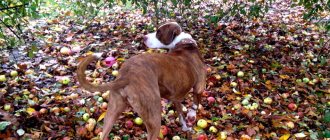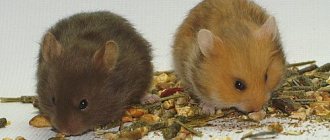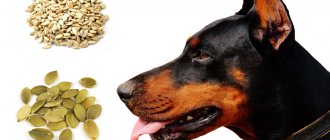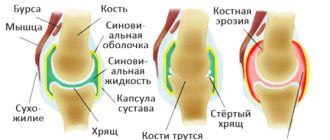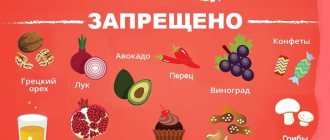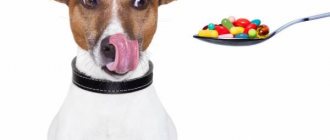Benefit
Pumpkin affects the animal as follows:
- normalizes the functioning of the digestive tract;
- eliminates pain and discomfort in the abdomen, preventing flatulence;
- fights helminths, destroying them;
- fills the body with vitamins and minerals, which helps strengthen the immune system and improve general condition.
It is useful to give pumpkin to your dog if there are stool problems. It helps cope with diarrhea and constipation, heals the intestines and normalizes its functioning. If the stomach hurts, it will help cope with the discomfort and cure the animal.
Pumpkin for constipation and diarrhea
Most people try adding pumpkin when they think their dog or cat has constipation or diarrhea. How can the same substance help with both diarrhea and constipation?
It's all about the balance of fiber contained in pumpkin and how it helps with digestion and GI health.
Many dog and cat lovers think that a spoonful of pumpkin is a remedy for the gastrointestinal tract, but give too much or continue to feed pumpkin when it does not help the problem. This will make the problem worse and delay recovery.
If you try pumpkin for a GI illness and it does not resolve the problem within 24 hours, contact your veterinarian for help.
The fiber in pumpkin is intended to help regulate bowel movements, but fiber is complex and not a one-size-fits-all remedy.
How to cook porridge?
Pumpkin porridge for dogs is a healthy and tasty treat. It is not difficult to prepare.
You will need:
- 250 g rice;
- 400 g pumpkin;
- water.
The rice is placed in a saucepan and filled with warm water so that its level is 1-2 cm above the cereal. Cook over low heat. At this time, you need to peel the pumpkin, grate it on a coarse grater or cut it into cubes, and add it to the rice.
You also need to add a little water to make the mixture less thick. There is no need to add salt and sugar to it, as they can negatively affect your pet’s digestion. The mixture is left to simmer over low heat until the pumpkin and rice are soft. Depending on the variety, it will take 15-25 minutes.
When the food has become soft, remove the dish from the heat and allow to cool. It is ready, you can feed your pet delicious porridge.
How to give?
It is enough to give this product to your pet twice a week. A serving should not exceed 200 g. Pumpkin can be a separate dish, but it can also be mixed with cereals: buckwheat, wheat, rice. The result is a nutritious, tasty porridge.
Oil
Pumpkin oil contains:
- vitamins: B, E, A, C, F, K, P;
- Omega-3, Omega-6;
- minerals: magnesium, iron, zinc, phosphorus, calcium.
These components strengthen bones, eliminate inflammation, improve heart function, preventing heart disease.
Dogs can be given pumpkin seed oil. It does not harm, it heals the body. It is enough to feed your pet with it 2 times a week.
Seeds
This product can be given to your pet, but as a treat or addition to dinner. In too large quantities, pumpkin seeds can put a strain on the liver and gallbladder, leading to disruptions in their functioning.
Give them 2-3 times a week, a small handful will be enough to benefit the dog.
How to give pumpkin to a dog
Pumpkin is universal for feeding dogs; it can be combined with any food. For pets who eat exclusively dry food, raw vegetables are given as a treat and reward during training. Animals love baked pumpkin because it replaces forbidden sweets.
If you prefer to feed your dog natural products, pumpkin can be included in the diet in any form. The boiled vegetable is often mixed with cereals or meat.
Porridge
Porridge from pumpkin alone is rarely cooked. Typically, dog breeders prefer to combine several types of cereals so that the animal receives as many nutrients as possible.
Boil buckwheat and millet in meat broth. Add grated carrots, beets, pumpkin and small pieces of meat. Drain off the excess broth and stir the porridge.
If it gets bad
Your pet will feel sick from pumpkin if he ate a lot of it, it turned out to be stale, or he is allergic to it. In this case, the following are possible:
- flatulence;
- nausea;
- vomit;
- bowel dysfunction;
- lethargy, weakness.
The dog lies down, does not play, and refuses to eat. This condition can last from several hours to several days. It usually goes away on its own, without special treatment.
The animal needs to be provided with complete rest and avoid physical activity. It is recommended to give water. But if the pet does not get better, the condition only worsens, you need to contact a veterinarian.
Pumpkin and fiber puzzle
Pumpkin, like many other foods, fruits and vegetables, contains fiber. There are soluble complex carbohydrates, aka fiber, and insoluble carbohydrates, pumpkin having small amounts of both.
- Soluble fiber can act like a sponge when there is excess water in the gastrointestinal tract (diarrhea). Soluble fiber is found in foods such as oatmeal, apples and carrots. Pumpkin is not included in this list.
- Insoluble fiber does the opposite, pulling water into the gastrointestinal tract when stool is dry and hard (constipation) to make larger, softer stools. The main insoluble carbohydrates are wheat bran, some grains and vegetables. Again, pumpkin doesn't top the list.
Pumpkin is more than 90 percent water, about 3 percent fiber, and a source of potassium, antioxidants and other vitamins.
Now comes the crux of the matter: a pet with ongoing diarrhea or constipation needs a diagnosis, not endless spoonfuls of pumpkin or other supplements.
If your pet has loose stools or you think he may be constipated, try adding pumpkin to his diet for 24 to 36 hours while your pet is feeling fine. If the abnormal bowel condition does not improve or if your pet behaves poorly and unnaturally, contact your veterinarian.
Pregnant and lactating
During pregnancy and during feeding, the dog’s body is weakened and more sensitive to external influences. Quite often, owners encounter allergies and poisoning in their pets. For this reason, pumpkin is given with great care and in small quantities: no more than 80 g per serving.
If the dog is unwell and has a hard time withstanding this period, this product is contraindicated for it until it has fully recovered.
Healthy vegetables
Let's start with healthy treats. Let us immediately note that thermally processed foods are better absorbed than raw ones. The dog's body extracts more vitamins, for example, from boiled carrots.
Pumpkin
Helps with constipation and improves digestion in general.
Zucchini
Contains folic acid, calcium, potassium and vitamins. However, pumpkin is still healthier.
Sweet potato
If potatoes are considered potentially dangerous vegetables, then the presence of sweet potatoes on the menu is welcome. It contains many microelements. Portions should be limited, since the product, if abused, can provoke the development of pancreatitis and obesity.
Carrot
One of the most healthy treats. The treat improves vision and gives the coat a healthy appearance. Raw carrots help your companion brush his teeth, which is very important in a natural diet.
Beet
It often causes allergies and can change color, but in the absence of contraindications it will be beneficial. The delicacy improves digestion and helps remove waste and toxins from the body. If your dog has red fur, treats will highlight the shade. However, a large portion may cause diarrhea.
bell pepper
Contains many vitamins. You must first remove the seeds.
cucumbers
With a modest calorie content, they contain many vitamins: A, group B, C, D... Cucumbers freshen breath, but can cause diarrhea.
Asparagus
It has a beneficial effect on digestion because it contains a lot of fiber. In large quantities it weakens. Asparagus can turn stool green.
Celery
Only the stems are allowed to be fed. Portions should be strictly limited due to the risk of indigestion. However, celery has a significant advantage: the greens relieve inflammation and ease joint pain.
Turnip
Especially useful for kidney problems.
Radish
Due to the coarse fiber content, it is recommended to use radishes as a kind of brush. But don't let your dog eat too much.
Ginger
Controversial product. On the one hand, it is a powerful cancer prevention tool. Ginger also prevents motion sickness. On the other hand, ginger can only be given to healthy animals and in small quantities. For some, it causes individual intolerance and stomach upset. Large dogs can add up to 1/5 tsp to their food once a week. chopped ginger. For miniature pets, the dosage should be reduced.
Seaweed
Suitable examples include kelp and spirulina . Algae contain many unique beneficial substances. With regular use, your shaggy friends' fur begins to shine and their skin stops peeling. You should not overuse additives.
Owners of white dogs should be careful: some vegetables can change the color of your pet's coat. For example, carrots and beets. While this is not critical for pets, color damage is a serious obstacle for show companions.
What to replace it with?
If such food is not available, it is replaced by:
- melons;
- spinach;
- bananas;
- pears;
- carrots.
These are sources of vitamins that are allowed to be given to dogs. In terms of the amount of useful substances, they are not inferior to pumpkin. Animals tolerate them well, regardless of breed.
If you want to supplement the pumpkin with other products, you should focus on cereals: rice, buckwheat. It is also combined with lean meats and carrots. The result is a tasty combination that pets love.
Dry food
Owners of Yorkies are often at a loss when faced with a difficult choice: to feed their Yorkshire Terrier dry food or give them only natural products. The answer is: food must be properly balanced, of good quality and freshly prepared. There is no need to feed only dry food or natural products.
Let's look at what options manufacturers offer:
- Economy class. Such foods contain minimal amounts of beneficial substances, so there is practically no benefit to the dog’s body. If you frequently consume food of this quality, your dog's health may deteriorate. Dry food has one advantage - its price;
- Custom class. The products contain large quantities of artificial additives. They are harmful to your pet as they can cause allergies. It is often not recommended to give this food to a Yorkshire Terrier;
- Premium class. These dry foods are high-class and have good quality, but they can be pricey; this is their only drawback. The food contains microelements and vitamins necessary for the dog’s body.
Food is selected for dogs according to their age category. Small puppies are not suitable for food that is given to adult dogs. If a Yorkshire Terrier is accustomed to dry food, it is undesirable to suddenly and forcefully switch it to natural products. The transition should be smooth within two weeks. Mixing these types of feed is also not recommended.
Dry food also has its advantages - manufacturers take into account the needs of a specific dog breed when developing them. Therefore, they are as balanced as possible, containing all the necessary ingredients and complexes beneficial to the body. The calculation of one serving is simplified.

